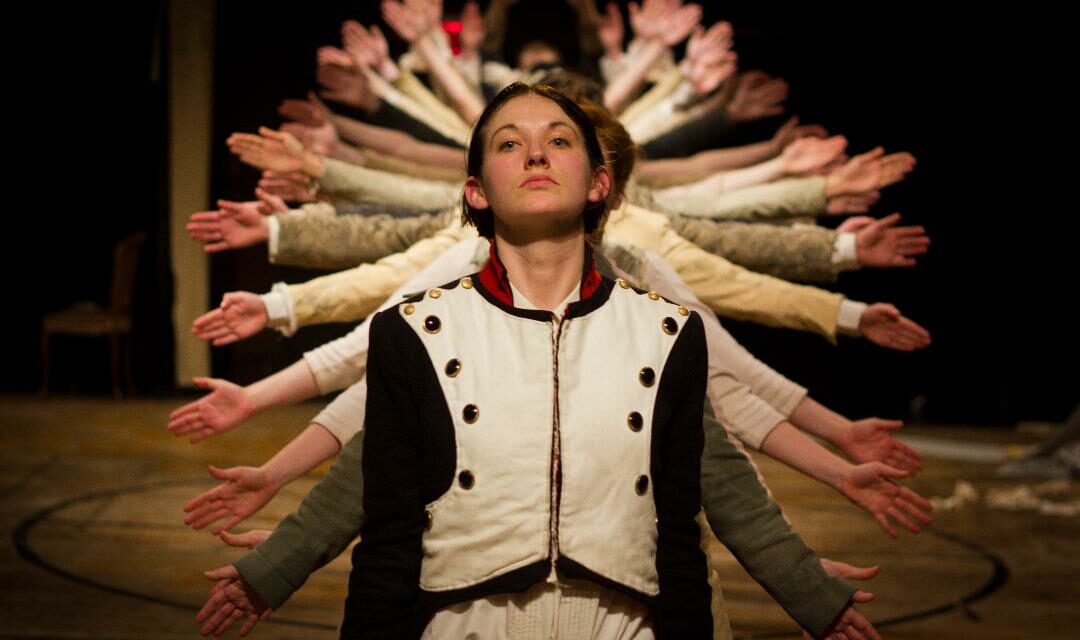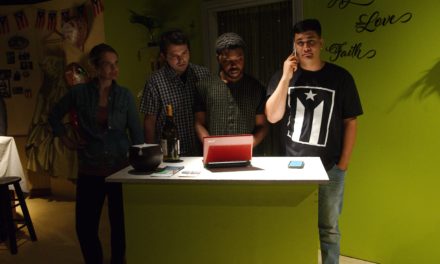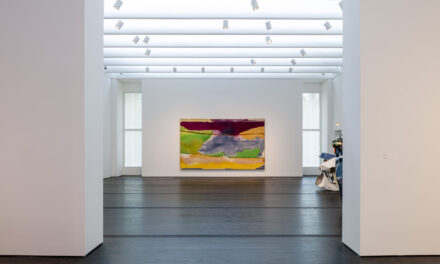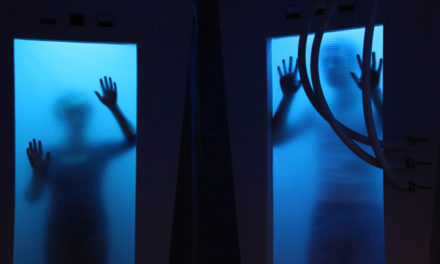Rebecca Wright is a director and devisor based in Philadelphia. She is the co-founder and artistic director of the critically acclaimed company Applied Mechanics, celebrating its ten year anniversary this year, in addition to being a prolific freelance director in the greater Philadelphia area. I spoke to her over the phone to discuss her history with Applied Mechanics, her approach to ensemble theater and her plans for the future. The following has been edited from that conversation.
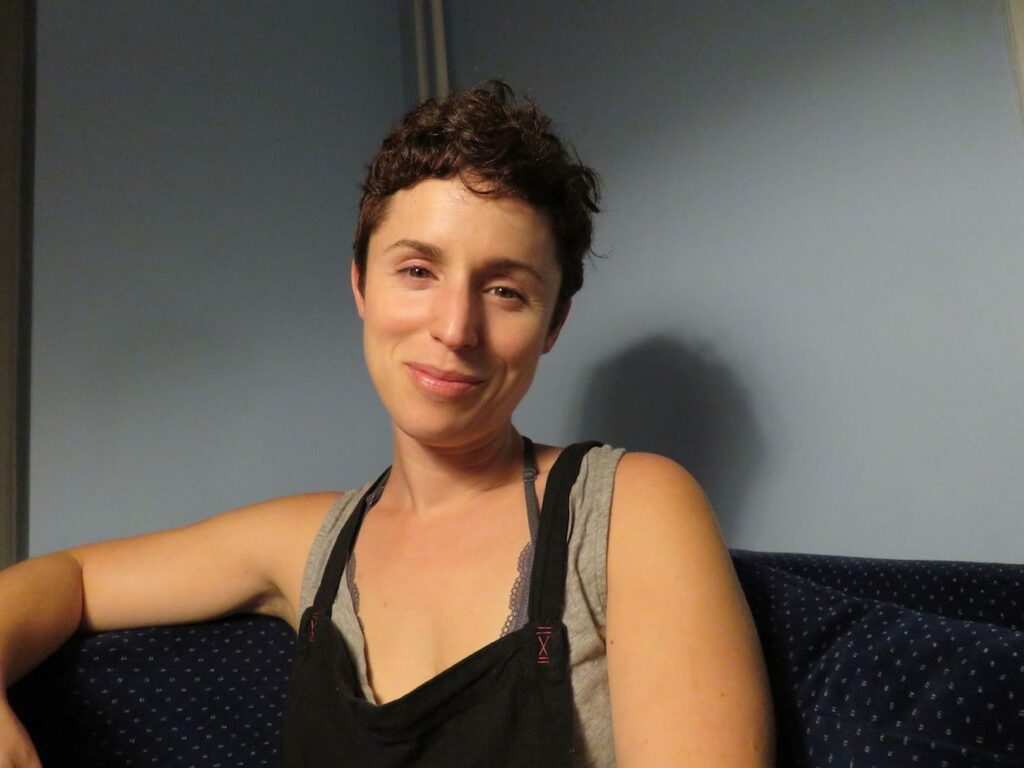
Rebecca Wright Headshot by Adriano Shaplin
The only show of yours that I’ve been able to see was your 2015 production of Stephen Berkoff’s The Metamorphosis at Quintessence – a 1969 adaptation of a 1915 Kafka story. What drew you to that piece and how did you go about developing the Berkoff script to match your vision?
Alex Burns, the artistic director of Quintessence approached me to direct that play – it was not one that I chose myself – so the real answer to what drew me to it was that I got offered a job directing it. He’d seen a bunch of my work, particularly with my company Applied Mechanics so he thought of me as someone who was movement driven and ensemble based – which is the heart of a lot of the work I do.
When I read the script of The Metamorphosis it really read to me like somebody else’s devising process, and I have a foot in the devising world, I split my time between developing new work with groups of artists and directing existing work, so I know a devising script when I see it and that script read to me like they started with the story and developed an adaptation, and that the script was really a record of what they worked out in the room.
So the fun and interesting thing about a script like that is that it’s a little bit indecipherable, you can’t just follow the instructions. What you really have to do as a director is figure out the prompt they gave themselves to come to that answer, and your answer to that prompt might be different.
There’s always interpretive work you do when you’re starting with a script, but in this case, I felt the interpretive work was putting myself in the mindset of somebody adapting this short story. I was in conversation with both the Berkoff script and the short story, and there were things about the Kafka story that, to me, were centrally important that didn’t make it into Berkoff’s adaptation, or made it in in funny ways and then there were other things that Berkoff answered for himself like the way they did the body of the bug that to me seemed irreproducible – there wasn’t really a way to do it like they did it.
So what I did was get an ensemble of actors that I really was hyped about together and work out our own answers to some of those prompts. The first day of rehearsal we read the script and we read the short story out loud; we had done a lot of physical work before we even started working on the script – which is not always what I do, but in that case, it felt really important to develop a physical language to bring to our work on that script.
That’s a very long answer to your question.
No, it’s great! You mentioned your work with devised theater. What initially drew you to that form?
I spent a long time working in literary departments when I was first out of undergrad, and then after grad school as well, so I became really well acquainted with the tyranny of the playwright. I think there’s a lot of great playwrights out there, and definitely there are many plays that I love, but I think it’s an unfortunate thing about American theater that we still have this idea that’s sort of passé in the rest of the world that everyone’s job is to serve the playwright and that the playwright’s vision should be the guiding vision of the work.
That to me seems sort of silly and antithetical to what’s at the heart of theater for me which is collaboration, and I think everyone from the [Assistant Stage Manager] over to the set designer over to the director over to the actor – all of those jobs are really important, and you need all those jobs to make the thing go. I’m drawn to devised theater because there’s a real potential to center a process on collaboration and celebrate collaboration in the process.
I do that in non-devised work as well but there seems to be the potential to have a non-hierarchical structure more automatically built into devising. I know that not everyone devises that way but for me, that was the opportunity that it opened up. That and to work with performer-creators, people who are great at writing and don’t need to fashion themselves as the only writer in the room as opposed to many many playwrights who get the message that they’re the most important person in the room.
I like working in a room where everyone thinks that the room is what’s important, not themselves. That can be a challenge, but devised work opened that up for me.
And immersive work?
I saw a lot of immersive work, particularly in grad school, and was really excited by it. My grad program was focused on getting us to step back from the medium of theater, really take it apart and think about how it worked and why it worked and what we liked about it. Immersive theater really got at the heart of my early, early experiences of theater as a kid where I’d be in the middle of it and it was so magical. I’d been working long enough at that point that I felt tired of the setup where I sat in a dark room and looked at a lit stage and saw what somebody else determined I should see as opposed to being surrounded by a world. Immersive theater literally does that.
It’s interesting, it’s quite trendy now but when we started making it ten years ago it was still hard to explain to people, “it’s like a haunted house but it’s not scary.” Now we’ve crossed over to the other side of it where it’s a kind of buzzword and really famous big-budget productions have things [where] they serve you food and everyone says that they’re being immersive.
We’re trying to think about our next experiment and other ways of fashioning an immersive experience other than what we’ve done so far, but what we’ve done so far is fill up a big room or an entire building with a set and have many stories happening at once that intersect, and leave the audience to wander through and watch what they want.
That felt really important to me and to Maria Shaplin who started the company with me, partly for this theatrical, magic feeling and partly for, again, this non-hierarchical approach to storytelling. That, and what we internally refer to as a democracy of viewership where you’re not saying “this is the important stuff.” You’re making a world with a lot of important stuff in it and then empowering the audience to choose what they watch without telling them they made the “right choice” or the “wrong choice” or “this is more important than that” but really saying that every life in this world has equal value.
The choices you make, as an audience member, are the choices you make. You saw something great, you missed something great, that’s all good. You still get the whole story no matter what, but that choice you made doesn’t mean that one life has more worth than another life. There really was a sort of political undergirding to our interest in the form.
One of Applied Mechanics’ largest shows was 2012’s Vainglorious where you had 26 actors re-enact 20 years of European history all simultaneously telling different stories. What inspired that project and how did you about assembling and choreographing something so sweeping?
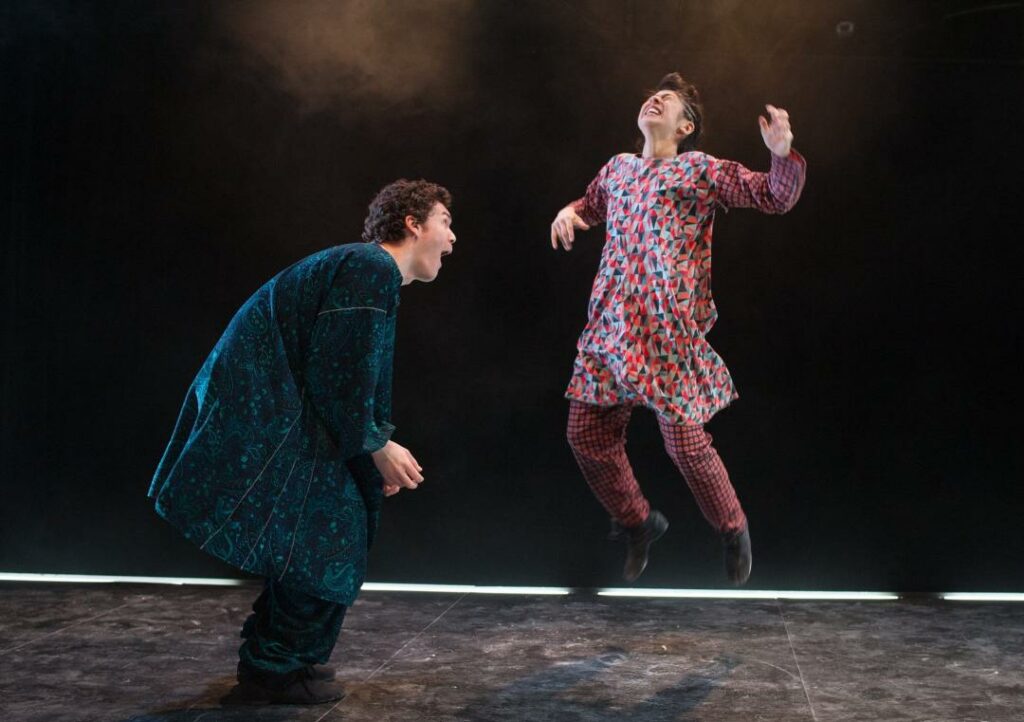
St. Joan by George Bernard Shaw, produced by Quintessence Theater Group, photo by unknown Photo provided by Rebecca Wright
That project was initially inspired by three Applied Mechanics company members who drunk dialed me and were like, “We want to make a piece about Napoleon and Josephine and it would be so amazing oh my god!” One of them had a kind of sweet tooth for Napoleonic history, and they all were jamming out on that history – we’re nerds!
I really think they got drunk and were talking about Napoleon and started daydreaming and then gave me a call. And the fact that Napoleon and Beethoven were alive at the same time and were such amazing figures stuck with where we were in our arcs as artists and our ambitions at the time.
Applied Mechanics is pretty devotedly democratic and non-hierarchical, I don’t determine the projects, they’re determined by group volition and group vision and there was a lot of energy behind the group’s desire to make that piece and it felt like it had to be really big.
We got our first grant around that time so we were like, “we can fund this.” No one got paid that much but someone just gave us money for the first time so we used that money to pay 26 people to do a thing. And each of the performing mechanicians (Applied Mechanics company members), at that point we had five, they each were the most famous figure and then each of them had a team of five people who were the figures surrounding that figure. Mary [Tuomanen] played Napoleon, who had a slightly bigger team of six, and each of those six people would play a soldier or his son-in-law or his stepson; they each played a person in his life. Thomas [Choinacky] played Beethoven and on his team, there was someone playing Beethoven’s brother, someone playing his assistant.
So we’d organize into factions and for a lot of the time we were devising it the factions worked separately so each of them really developed their own culture and their own arc. And then there was this grand process of putting those different vocabularies, those different arcs together in a room and weaving them together so they lined up in a compositionally interesting way.
We did a bunch of work with the core mechanicians after we had cast but before we brought all those other people into the room to figure out what the major depicted events were going to be. There was a big map that went along with that production that showed what all the events were and where in the room they’d be happening.
Also at that time, there was the primary content and then there was ancillary thematic content. We’d start with research, get these course packets together of research, now we have an online component too so we can have video and that sort of stuff but at that time it was mostly print material. So we had this big-ass course packet on Napoleon and this other big-ass course packet on size and scale and fame – those were our thematics that we were looking at through the lens of Napoleonic Europe.
A lot of that research also contributed to how the performance style worked in that piece. We had a period of development sessions that was just exploring those themes and exploring the history before we brought in the additional 21 performers.
I look back on that now and I think “what the fuck” because we did all of that and we still built the whole piece in five weeks. We had some weeks on our own to do the undergirding but then from day one of rehearsing with all 26 people to opening was five weeks.
That’s massive!
It was mammoth! And we did get to remount it the following year which was wonderful. We didn’t change very much of it, we had to recast a few people but we changed very little of it. It’s such a huge feat that I think we were a little bit in a daze the whole time we were doing it, and it felt enormously successful and was super duper sold out and was this kind of runaway hit for us. And it was community building, there were so many people involved. It was super nice to get a second run of it and get a chance to enjoy its existence.
Is that your typical process for devised work? You get an idea, then you do specific research and thematic research and then you manifest it from there or does it change from project to project?
It both takes that form and changes a bit from project to project depending on what the needs of the project are. Our process at this point has really expanded, the thing that we used to cram into five weeks is now spread over about a year and a half. And that’s so there can be gestation time, so we can be more mindful about certain stages of the process. We’ve also tackled increasingly complicated political and thematic materials so we want to give ourselves more time to do research, more time to do exploration, so on and so forth.
I talk a lot about our company structure and how we go about doing our work. We’re self-administrating so we do all of the admin together too and we’re really in constant conversation with each other so when an idea takes hold it’s mostly because it’s something we’ve been talking about something and it becomes the next piece we’re going to make. As the director, it’s kind of my job to point to that decision and articulate it but it’s always a group decision, we’re pretty consensus driven.
On the topic of thematic choice, I was reading about your 2014 production We Are Bandits. The Applied Mechanics website said it asked the question “how is it possible to affect change in our contemporary American present?” which strikes me as a more and more significant question. As a contemporary, American artist yourself, do you have an answer to that or was it more of a hypothetical to get the audience thinking?
I don’t know if I believe in answers. I think with something like that the question in a way is the answer. If you are always asking yourself how you can participate in emancipatory politics or social transformation, then you are participating. There’s a version of that where you’re paralyzed, for sure, but if you’re experimenting with answers to that question and leaving your house then you’re participating.
I think the structure of Applied Mechanics work really does tell the audience that they are participants in the world and that’s one of the ways it enacts its politics. We’re trying to get that show remounted because when we made that show people were like “whoa, this is political!” People were excited about it but they were also like “I haven’t even thought about this stuff” and it seems like now everyone is thinking about that stuff.
It really does speak to the moment that we’re in now, it was a little bit ahead of its time. But what that piece does – and this is one of the really amazing things about parallel narratives and immersive work in the structure that we do it – is that there were eight characters in that piece and each of them explored a different possible answer to that question. Each of them was really trying to participate in social chance in eight very different ways, and those differences came from their social background, their social status, how they positioned themselves in relation to their political world and also their personality traits.
You really got to see eight different people answer that question and then you’d leave and talk to your friends about who did it most effectively, or you’d come back and watch somebody else and see if they provided more of an answer.
Applied Mechanics, in and of itself – and really theater as a form – is making the case that the way that you [tackle these questions] is by creating, maintaining, enhancing, and growing spaces that function by an alternative logic. Anyone who works in theater, whether they know it or not, has tacitly cast their lot with people who prize things other than money which is pretty radical in capitalist America.
If what you want to do is make money, you should not go into theater, if you go into theater you’re saying there’s something that matters to [you] more than making money, and if you’re aware that that’s the contract that you’ve signed then you can really build a community around that, and if we were a country full of people building community around values other than money making it would be a very different country.
My personal answer, and this isn’t a satisfying answer because it’s not an arrival point and it doesn’t instantly ferment a revolution, but I do believe in the power of individual change and something sending ripples out by making very very good work locally. That and centering your work and your working life and your beliefs on social practices rather than profit-making practices.
I know you have to go soon but are you working on anything right now you want to talk a little bit about?
This is a really exciting moment both for me personally and for Applied Mechanics. We just made our biggest show since Bandits this past summer called This is On Record and it was another big sweeping political exploration. This time it was on the politics of media and dissemination of information and the obfuscation and unearthing of radical histories. This was a huge show for us, it was our first majorly multi-media show and it produced all this ancillary media.
There’s the piece itself and then there’s also an album and a documentary and a children’s book, all of this stuff that came into being because the characters in the show are making that stuff. It’s just gigantic and it completed a trilogy that we have been working on since We Are Bandits, so we definitely had a few months after that of going “what’s next?” and now we’re just getting started on our next wave of work which I think is going to be looking at ascending generations, and the question of what’s the opposite of dystopia – other than utopia which doesn’t exist – along with what are the responsibilities of “middle management” aged people who are caretaking both children and elderly.
It’s super nascent, we’ve only had one workshop on it and we have our next one coming up in March. That’s really exciting, I think we’ll be making a two-person show and a big big big show in the next three years based on these themes. So I have that in early early stages of Applied Mechanics work which is really exciting because anything can happen and then personally my season as a freelance theater director which is a lot of what I do, it’s a really interesting season.
In the fall I had probably the most experimental piece I’ve ever worked on – this super boutique, a luxury, text-driven piece for an audience of one to four that happens in this speakeasy theater in Philly. It was this super underground, radically experimental piece. And in the spring I’m directing [Paula Vogel’s] Indecent at the Arden, this huge, rich regional theater. It’s funny, the script reads a lot like the Berkoff script, like “this is somebody else’s devising process,” it really really reads like that but nevertheless it’s basically the opposite of Perfect Day, the experimental thing I did in the fall. It’s as opposite as it gets.
So it’s a fun and funny moment for me as a director because my straddling of these different worlds is suddenly extremely pronounced and dramatic and that makes for a very fun moment in my career.
This post was written by the author in their personal capacity.The opinions expressed in this article are the author’s own and do not reflect the view of The Theatre Times, their staff or collaborators.
This post was written by Ian Stewart Riley.
The views expressed here belong to the author and do not necessarily reflect our views and opinions.

